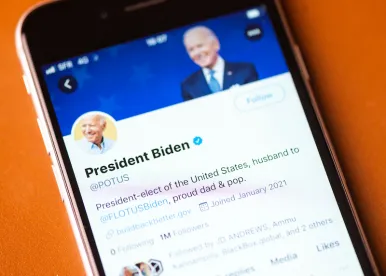On 29 December 2022, President Biden signed into law the SECURE Act 2.0 (SECURE 2.0) as part of the Consolidated Appropriations Act of 2023. SECURE 2.0 builds on the 2019 passage of the Setting Every Community Up for Retirement Enhancement (SECURE) Act. SECURE 2.0 includes a variety of provisions that are designed to promote savings by Americans for retirement, boost incentives for businesses to facilitate employees’ saving for retirement, and offer more flexibility to those saving for retirement.
Given the increasing and widespread acceptance of exchange-traded funds (ETFs) as valuable investment options, it should not be surprising that SECURE 2.0 includes ETF-related provisions. Yet what SECURE 2.0 envisions for the future of ETFs is somewhat surprising.
SECURE 2.0 directs the US Department of the Treasury (Treasury) within the next seven years to amend its regulations1 to allow for the establishment of insurance-dedicated ETFs. To repeat, SECURE 2.0 envisions a new type of fund—one that is listed on a national securities exchange, assigned a ticker symbol, and traded throughout the day at market prices that are reported on the consolidated tape, yet purchased (indeed, traded) exclusively by insurance company segregated accounts that hold the assets of variable life insurance and annuity contracts (hereinafter, insurance-dedicated accounts).
Why, one may ask, would SECURE 2.0 propose an ETF that is only held by insurance-dedicated accounts? The answer is likely two-fold. First, current regulations—the ones that SECURE 2.0 seeks to amend—require that insurance-dedicated accounts must meet certain asset diversification requirements and that they allow such accounts to meet those requirements by investing in a single fund (and look through to the fund’s underlying portfolio for diversification), but this look-through is only available if (i) all the beneficial interests in the fund are held by insurance-dedicated accounts, and (ii) public access to such fund is available exclusively (subject to certain exceptions) through the purchase of a variable contract. SECURE 2.0 does not attempt to change these look-through requirements other than to expand the exceptions to the exclusive ownership rule to include authorized participants (APs) and market makers.
The second reason for restricting ownership of insurance-dedicated ETF shares to insurance-dedicated accounts lies in the “investor control doctrine.” The investor control doctrine—which is an Internal Revenue Service (IRS) and court-developed doctrine that is not addressed in the regulations—precludes owners of variable life insurance or annuity contracts from exercising too much control over the investment of the insurance-dedicated accounts underlying those contracts. According to the IRS’s interpretation of the doctrine, a variable contract holder’s involvement in the underlying segregated account’s investment decisions, at least in the case of investments in funds, must be limited to choosing from a discrete list of insurance-dedicated funds made available by the insurance company, with such funds being available exclusively through the purchase of a variable contract. In a sense, the investor control doctrine expands the regulations’ exclusivity requirement for the look-through rule and makes it an all-or-nothing requirement for a contract’s classification as a variable life insurance or annuity contract.
At first blush, it may seem that an insurance-dedicated ETF is impossible for one obvious reason—namely, there is a fundamental inconsistency (maybe even an oxymoron) in the notion of an exchange-traded security that can be bought and sold exclusively by a limited group of investors (i.e., insurance company segregated accounts). Indeed, one of the hallmarks of an exchange-traded security—and the primary reason that the U.S. Securities and Exchange Commission (SEC) has historically been particularly rigorous in administering listing standards that allow for the listing and trading of securities on a national securities exchange—is that once a security is so listed and trading, anyone can buy or sell it, as long as they have a brokerage account. And this has historically been true of ETF shares—as exchange-traded securities, they are available for purchase and sale by anyone with a brokerage account.
Thus, the ETF structure contemplated by SECURE 2.0 leaves us with the question of how an insurance-dedicated ETF could work. To a limited extent, SECURE 2.0 itself provides an answer. Specifically, the provisions of SECURE 2.0 recognize that ETFs necessarily have two types of shareholders that are not insurance-dedicated accounts:
First, ETFs must have a market maker as all listed and traded securities do.
Second, they must have APs, which pursuant to SEC regulations are uniquely allowed to purchase shares directly from an ETF and redeem shares directly to the ETF, including for market-making activities by the ETF market maker.
To harmonize the requirements of the current regulations and the necessity of market makers and APs holding an ETF’s shares from time to time, SECURE 2.0 issues two directives—one to Treasury and one to market makers and APs.
With respect to Treasury, SECURE 2.0 directs it to revise the regulations to expand the exceptions to the exclusivity requirement to permit investment by market makers and APs. As long as they are contractually obligated or legally required only to sell ETF shares to insurance company segregated accounts (or other investors included among the regulations’ exceptions), they will not be treated as an impermissible holder of the ETF’s shares.
With respect to market makers and APs, SECURE 2.0 directs them to enter into such contractual arrangements limiting the persons to whom they can sell shares of insurance-dedicated ETFs.
This requirement for market makers and APs, however, presents a conundrum. Contractually, while it may not be difficult for APs to enter into contracts that obligate their clients to represent that they are acting only on behalf of insurance-dedicated accounts, it would seem to be nearly impossible for a market maker to do the same.2 The core job of the market maker is to stand ready to buy and sell shares in response to investor demand, wherein investors are anonymous to a market maker. Also, even if a market maker sells ETF shares only to insurance-dedicated accounts, there is nothing that prevents the insurance-dedicated account from selling the ETF shares openly on the market to other types of investors. Further, it is not clear what statutory or regulatory changes could be made to ensure that only insurance company separate accounts purchase such an ETF’s shares in the secondary market. Again, the very nature of the secondary market is to permit retail investors of any stripe to buy largely any security that is listed and trading.
We currently see the following possibilities:
With significant assistance from one or more of the exchanges, it might be possible to set up an exchange on which trading is limited to insurance-dedicated accounts or to develop tickers that may only be traded by insurance-dedicated acccounts. This would likely be a long-term undertaking and would require material coordination with the SEC. In addition, it may have little market appeal, either to insurance-dedicated accounts or insurance companies.
The IRS could adjust the investor control doctrine. Although the doctrine has been endorsed by the courts,3 the IRS has largely developed, interpreted, and administered the doctrine and has shown some flexibility in applying it in different situations.4
Treasury could modify the investor control doctrine, relying on the directive in SECURE 2.0 “to facilitate the use of exchange-traded funds as investment options under variable contracts.” That said, Congress did not seem to envision SECURE 2.0 as requiring a departure from the investor control doctrine. Indeed, the legislative history suggests the opposite—namely, that ETFs could somehow be insurance dedicated.5 Accordingly, this may be an avenue of last (or no) resort.
It remains to be seen whether an insurance-dedicated ETF can be launched and gain widespread market acceptance. Likely, one or more stakeholders in the ETF industry advocated for these provisions in SECURE 2.0 and may have thought through how to make the structure viable. Given the amount of assets in insurance-dedicated funds (approximately US$1.2 trillion outside of retirement plans), we certainly understand stakeholders’ interest and look forward to exploring its potential for implementation.





 />i
/>i
